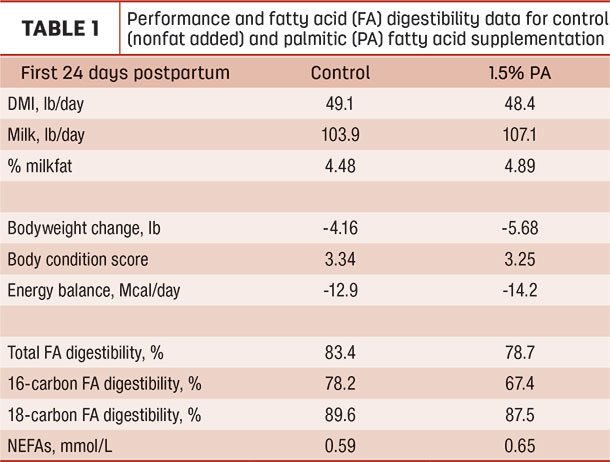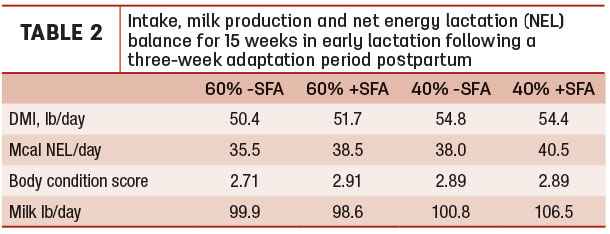In a previous article, I noted that high-palmitic-fatty-acid (greater than 80%) supplements most often decrease dry matter intake (DMI). And, since many studies with that type supplement have been done with midlactation cows over a short term (21 days), it raises the question as to what would be the response in early lactation cows?
Such a study was done in two phases: for the first 24 days, and then for the following 42 days. That takes cows just past seven weeks post-calving. Fifty-two cows (no first-calf heifers) were fed either a control no-fat supplement diet or 1.5% of a palmitic (PA) fat supplement. That was followed for the next 42 days (six weeks) with each treatment group split in half into four different treatment groups with cows either being on the same supplement as they had been on during the first 24 days or on the other treatment, which they had not been on. Thus, there were only 13 cows per treatment group during the second phase.
I have wondered why there wasn’t also a third diet with a palmitic/stearic fatty acid blend – the most commonly used fat supplementation. While the first phase diets had 51.6% forage from corn silage, alfalfa hay and alfalfa silage, the next phase diets, inexplicably, only had 42.8% forage from a corn and alfalfa silage combination along with 2.76% wheat straw. Why use such an atypical diet? Key data are shown in Table 1.

The most obvious benefit to PA supplementation was 3 pounds more milk with 0.4% more fat. But, there were also other data accompanying that benefit. There was 0.7-pound lower DMI, more body weight and body condition loss, more negative energy balance, and increased non-esterified fatty acids (NEFA), indicating body condition mobilization. Lower fatty-acid (FA) digestibility for both 16-carbon and total FA may simply reflect that as more FAs are fed (in this case 16-carbon) increased FA intake lowers FA digestibility. When these changes are taken collectively, they present a picture of cows struggling to increase milk yield that has more fat, but with lower DMI and doing it by going into more negative energy balance. That is not a good way for cows to begin lactation.
The picture did not get better over the following six weeks as DMI was 1.76 pounds less for the PA treatment versus the non-fat-added control diet. These comparisons got more complicated with fewer cows, as half the cows from each treatment were fed the other diet in this second phase, which they had not been fed during the first 24 days. The PA cows did produce 9 pounds more milk with 0.16% more fat, but body condition was also lower (2.98 versus 3.10), as was body weight gain (0.35 versus 0.64 pound). However, neither energy balance nor NEFAs were reported during this phase.
I like to think of a cow’s energy balance as a bank savings account. As savings or energy are withdrawn, at some point they need to be replenished or future purchases will be more limited.
I was involved in the planning of another study, in which we wanted to measure cows’ responses to fat supplementation in early lactation over a longer period of time than the study reviewed above. We also wanted to see what the impact would be to feeding lower or higher forage levels. So, we used a mostly saturated, free fatty acid blend of palmitic and stearic supplement (SFA) at 2.25% of the diet, which would not decrease DMI. In formulating the lower 40% forage diet (all diets were two-thirds corn silage and one-third alfalfa silage, on a dry matter basis), starch was limited to 28% and then decreased to 25% with added 2.25% SFA, while the higher 60% forage diet starch was 1% to 1.5% units greater. This all is critical because the potential benefit to supplementing cows’ diets with fat in early lactation is because of their limited DMI, increased energy needs and not wanting to lower DMI when using a fat supplement. After all, if fat supplementation decreases DMI, that is at least partially defeating the purpose of using fat to enhance energy intake and limit negative energy balance.
A mix of 13 cows and five first-calf heifers were used in each treatment – reflecting that heifers are a significant portion of most herds, and their DMI and milk production are more limited than cows. Thus, heifers’ milk-yield response and energy balance may benefit even more by fat supplementation without DMI decrease. The conundrum with doing studies with fresh/early lactation cows is when to start feeding experimental diets. We chose to block animals in late gestation and assign them to treatments prior to calving, and then use the first 21 days of lactation as an adjustment period with a control diet. This period was then also used as a baseline (covariate) for statistical evaluations. The study was conducted for 15 consecutive weeks. This is much longer than the previously reviewed study and covered about one-third of a typical lactation. Key results are in Table 2.

Dry matter intake did not decrease for treatments with added SFA – the first key factor for a fat supplement. With 60% forage, the addition of 2.25% SFA increased net energy lactation (NEL) intake by 3 megacalories daily. Interestingly, that did not result in more milk yield averaged over this 15-week period, but it significantly increased body condition score. Why would this happen?
There is a theory that cows in early lactation will replenish body condition to a point before using additional energy for more milk production. Throw in first-calf heifers who also will grow another 10% during their first lactation, and milk yield priority may be secondary for them. Remember the savings account analogy? With only 40% forage diets, first notice that DMI is greater than for 60% forager diets, reflecting less bulk in these diets. Again, DMI is not lower with added 2.25% SFA. If there is a set point for body condition regaining in early lactation, it appeared to be about 2.9 in this treatment. Consequently, in this study, the additional 2.5 megacalories NEL were then used for increasing milk production from 100.8 to 106.5 pounds daily over those 15 weeks.
Extensive studies reviewed have shown the benefits of a blend of palmitic and stearic free fatty acids when fed to dairy cows. This review of two early lactation studies provides data on how and why this occurs. Other recent studies have shown that high (>80%) levels of either fatty acid may become crystalline, which could reduce their digestibility. Thus, it is best if a mix of palmitic and stearic fatty acids are first blended as a liquid prior to prilling as a mixture. Their complementary effects then appear to best play out.






